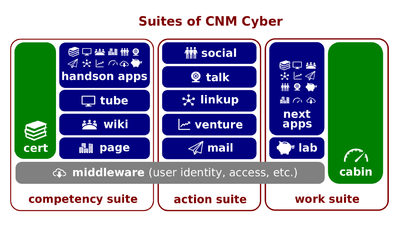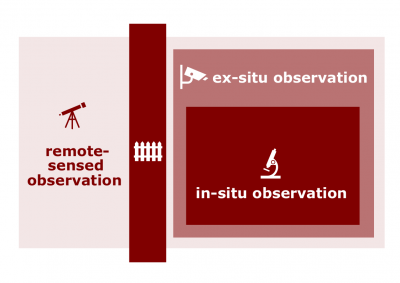Learning Management
The Learning Management (hereinafter, the Lesson) is the lesson of CNMCyber that introduces its participants to the ways in which learning process can be managed and facilitated. The Lesson belongs to the Introduction to Education session of EmployableU Concepts.
The Lesson is made up of four lectios. At CNMCyber, the word, lectio, is used for a lesson part.
Contents
Summaries
Predecessor
- The predecessor lesson is Educational Methods.
Outline
Successor
- The successor lesson is Certifications of Study.
2019 Learning Environments presentation
The video of the presentation is published on https://youtu.be/HBuBl26zDkQ (9:54). Here is its full text.
Overview
- Welcome to Learning Environments. In this brief presentation, we are going to take a look at those environments that may facilitate one's learning. Separate stops will be made by various educational formats, learning resources, and learning arrangements. Are you guys ready? Let's carry on.
Educational formats
- Starting with educational format which is they lay out of one's education. This lay out includes organization of roles, functions, technology and other arrangements for their learning process. There are many different learning educational formats. Every one of us is familiar with traditional class room which represents one teacher who narrates educational topics while using some board or display for demonstrating and one or more students listen to him/her. It could be one student, it could be three hundred and one depending on the educational institution.
- The flip classroom is the opposite, students are supposed to review the pre-recorded lectures or use other learning tools outside of the classroom and the teacher usually facilitates learning activities such as practical instruction, cognitive research and or experiential learning in the classroom. What is the most effective, it depends with the state of Colorado assumaely has many different statuses on this topic and they found that when the teacher is engaging the class, the flip classroom is more effective. If the teacher is not, traditional classroom works better. These two are not the only formats.
- On the job training is actually training provided at the work place. It can so that students can have some practical experience while working and he/she will have somebody or something to get knowledge, skills and abilities about the subject. Something can be learning tools like text books or massive online or on courses and this somebody can be a mentor. It can be one on one mentoring which is another educational format based on a relationship between one mentor and one student.
- Finally, in educational formats, we have a study group. This is a group of students that gather along specified topics. There is no one single format and once again every learner usually goes through several different formats. Traditional classrooms are the most recognizable probably because it`s the most cost effective, it gives results, some results at least in comparison let`s say with the study group and measurable results in comparison with one on one mentoring which sometimes may not be tested well but it gives like more practical experience. Anyway, there is no any single best educational format. And usually there is a combination of them.
Learning tools
- Format assumes some learning tools too, learning tool is any tool helpful I learning, it can be printed materials like text books, handouts, articles, or any other materials. It could be audio, it could be graphic materials like illustration charts or photographs, it could be audio visual materials like video files collections and malty media experiences, it could be a special system like learning management systems like collaborative knowledge systems, learning games and so on etc.
- Let's talk about MOOCS which is massive open online courses, this is a kind of computer aided education aimed at unlimited participation and open access via world wide web. Another learning tool which we use widely is learning management system. This is a system such as CNM Campus for administration, documentation, tracking reporting and delivery of educational courses training programs or learning and development programs. Usually the system is built on learning management system and our system is built on CNM Courseware. If you want to take a quiz or a test based on this lecture, you will go to CNM Campus and take a test there, CNM Campus can grant you a certificate or gives you some credential for your graduation from this particular course or from any other courses.
- Lastly in this learning tool section is the collaborative knowledge system. This is the system like we are using right now CNM Wiki for collaborative design, development and delivery of knowledge. Usually the system is built on content management software and our CNM Wiki is built on CNM Wiki ware. Right now you just review the material but if you go further you can contribute, you can edit, you can add, and you can use the system as your active learning tool.
Learning arrangements
- Finally, we are going to take a look at learning arrangements which is a particular way in which learning tools, educational formats, educational methods, certification and other techniques are put together in order to facilitate your learning. Here we have computer aided education which is any education format that is learning management system based on some software. It can be internship; internship is a period of professional experience offered by an organization for a limited period of time to students enrolled in programs related to that profession. Usually a college or university has a program that offer internship, let`s say if I am a university and I am preparing accountants it makes sense to have internship or offer internship. Some limit internship to students so they can practice or work as accountants at the company, sometimes pay sometimes they don`t. It depends on the arrangement. Apprenticeship is a little bit different, this arrangement when someone is called an apprentice learns on the job and often at some educational institution and apprentice actually is an employee of an organization and he or she has practice and he/she has some feedback on the job training and in many cases also has academic support. Some of the learning arrangements are based on elicitation technique and the technique is an established procedure for gathering any information from human beings and it can be anything from interviews, brainstorming, focus groups, artifact testing, observation or questionnaire survey.
Summary
- This concludes the Learning Environments presentation. We have defined learning environment and taken a look at its components such as educational formats, learning resources, and arrangements. Those arrangements that use elicitation techniques were specifically mentioned. If you haven't done yet so, you are now welcome to move to Certifications of Study.

